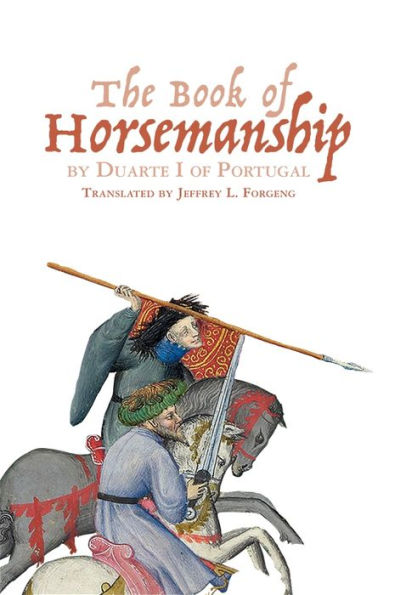The Book of Horsemanship by Duarte I of Portugal
First full translation of an important treatise on chivalric horsemanship.
Written around 1430, Duarte of Portugal's remarkable treatise on chivalric horsemanship, the Livro do Cavalgar (Book on Riding), is the sole substantial contemporary source to survive on the definitive physical skill of themedieval knight. It also stands out from the body of technical writings of the Middle Ages for its intelligence, insight, and intellectual versatility, ranging from psychological reflections on horsemanship and its implications for human ethics, to the details of how to couch a lance under the arm without getting it caught on armour. Under the general rubric of horsemanship Duarte covers a range of topics that include jousting, tourneying, and hunting, aswell as the physical apparatus of equestrianism and various cultural styles of riding.
However, despite its importance for scholarship, its language and technical content have so far resisted proper translation, a need whichthis book fills. The introduction provides not only the background to make Duarte's text comprehensible, but for the first time offers modern audiences a systematic point of access to the subject of medieval equestrianism in general.
JEFFREY L. FORGENG is curator of Arms and Armor and Medieval Art at the Worcester Art Museum, and Adjunct Professor of History at Worcester Polytechnic Institute.
"1141726818"
Written around 1430, Duarte of Portugal's remarkable treatise on chivalric horsemanship, the Livro do Cavalgar (Book on Riding), is the sole substantial contemporary source to survive on the definitive physical skill of themedieval knight. It also stands out from the body of technical writings of the Middle Ages for its intelligence, insight, and intellectual versatility, ranging from psychological reflections on horsemanship and its implications for human ethics, to the details of how to couch a lance under the arm without getting it caught on armour. Under the general rubric of horsemanship Duarte covers a range of topics that include jousting, tourneying, and hunting, aswell as the physical apparatus of equestrianism and various cultural styles of riding.
However, despite its importance for scholarship, its language and technical content have so far resisted proper translation, a need whichthis book fills. The introduction provides not only the background to make Duarte's text comprehensible, but for the first time offers modern audiences a systematic point of access to the subject of medieval equestrianism in general.
JEFFREY L. FORGENG is curator of Arms and Armor and Medieval Art at the Worcester Art Museum, and Adjunct Professor of History at Worcester Polytechnic Institute.
The Book of Horsemanship by Duarte I of Portugal
First full translation of an important treatise on chivalric horsemanship.
Written around 1430, Duarte of Portugal's remarkable treatise on chivalric horsemanship, the Livro do Cavalgar (Book on Riding), is the sole substantial contemporary source to survive on the definitive physical skill of themedieval knight. It also stands out from the body of technical writings of the Middle Ages for its intelligence, insight, and intellectual versatility, ranging from psychological reflections on horsemanship and its implications for human ethics, to the details of how to couch a lance under the arm without getting it caught on armour. Under the general rubric of horsemanship Duarte covers a range of topics that include jousting, tourneying, and hunting, aswell as the physical apparatus of equestrianism and various cultural styles of riding.
However, despite its importance for scholarship, its language and technical content have so far resisted proper translation, a need whichthis book fills. The introduction provides not only the background to make Duarte's text comprehensible, but for the first time offers modern audiences a systematic point of access to the subject of medieval equestrianism in general.
JEFFREY L. FORGENG is curator of Arms and Armor and Medieval Art at the Worcester Art Museum, and Adjunct Professor of History at Worcester Polytechnic Institute.
Written around 1430, Duarte of Portugal's remarkable treatise on chivalric horsemanship, the Livro do Cavalgar (Book on Riding), is the sole substantial contemporary source to survive on the definitive physical skill of themedieval knight. It also stands out from the body of technical writings of the Middle Ages for its intelligence, insight, and intellectual versatility, ranging from psychological reflections on horsemanship and its implications for human ethics, to the details of how to couch a lance under the arm without getting it caught on armour. Under the general rubric of horsemanship Duarte covers a range of topics that include jousting, tourneying, and hunting, aswell as the physical apparatus of equestrianism and various cultural styles of riding.
However, despite its importance for scholarship, its language and technical content have so far resisted proper translation, a need whichthis book fills. The introduction provides not only the background to make Duarte's text comprehensible, but for the first time offers modern audiences a systematic point of access to the subject of medieval equestrianism in general.
JEFFREY L. FORGENG is curator of Arms and Armor and Medieval Art at the Worcester Art Museum, and Adjunct Professor of History at Worcester Polytechnic Institute.
49.95
In Stock
5
1

The Book of Horsemanship by Duarte I of Portugal
180
The Book of Horsemanship by Duarte I of Portugal
180
49.95
In Stock

Product Details
| ISBN-13: | 9781783271030 |
|---|---|
| Publisher: | BOYDELL & BREWER INC |
| Publication date: | 04/21/2016 |
| Series: | ISSN , #5 |
| Pages: | 180 |
| Product dimensions: | 5.43(w) x 8.50(h) x (d) |
About the Author
From the B&N Reads Blog
